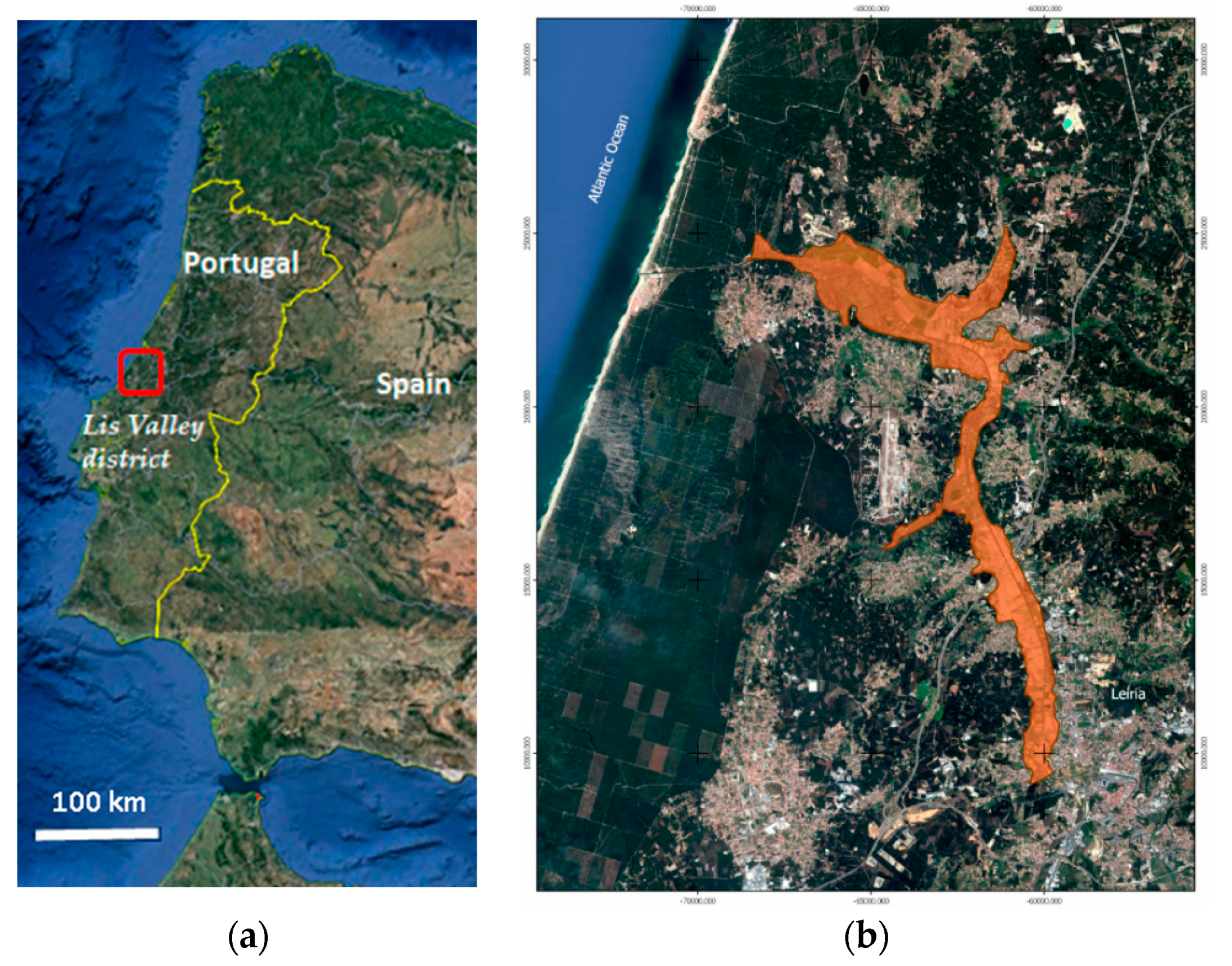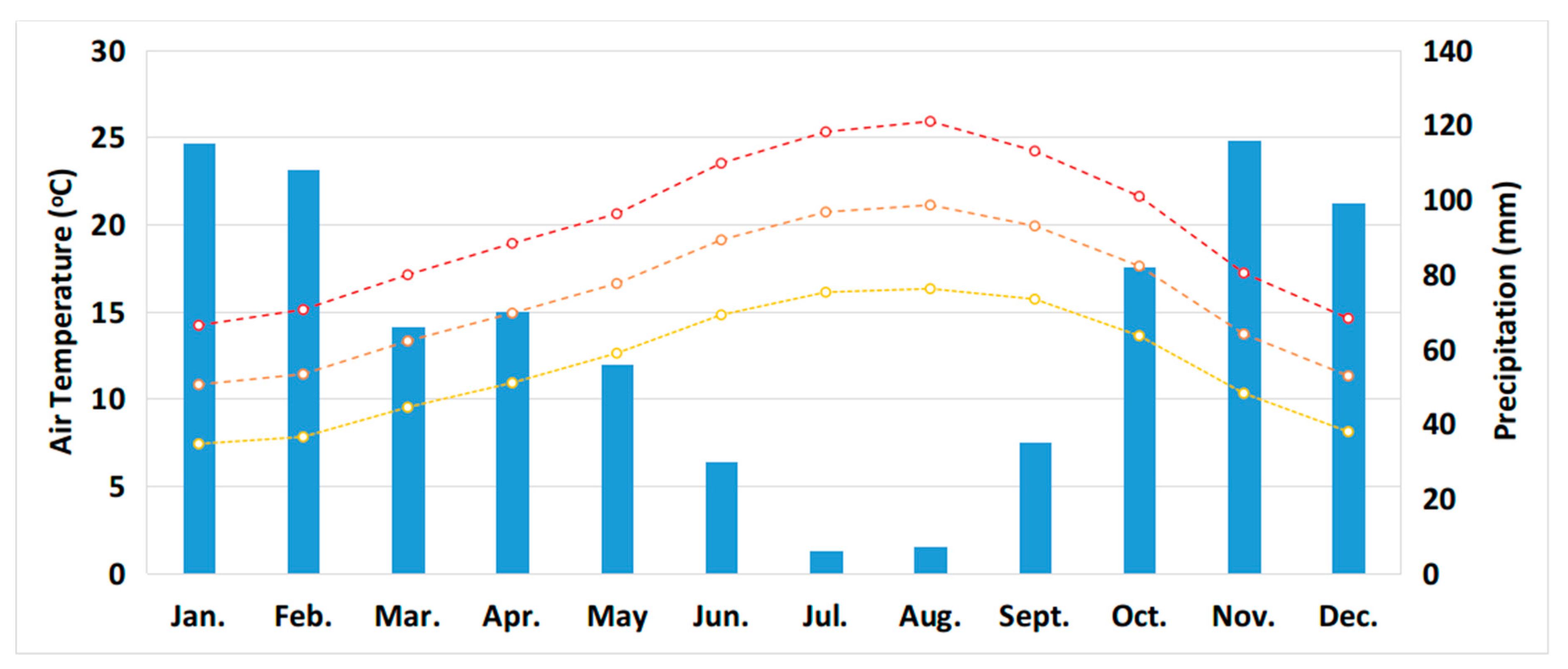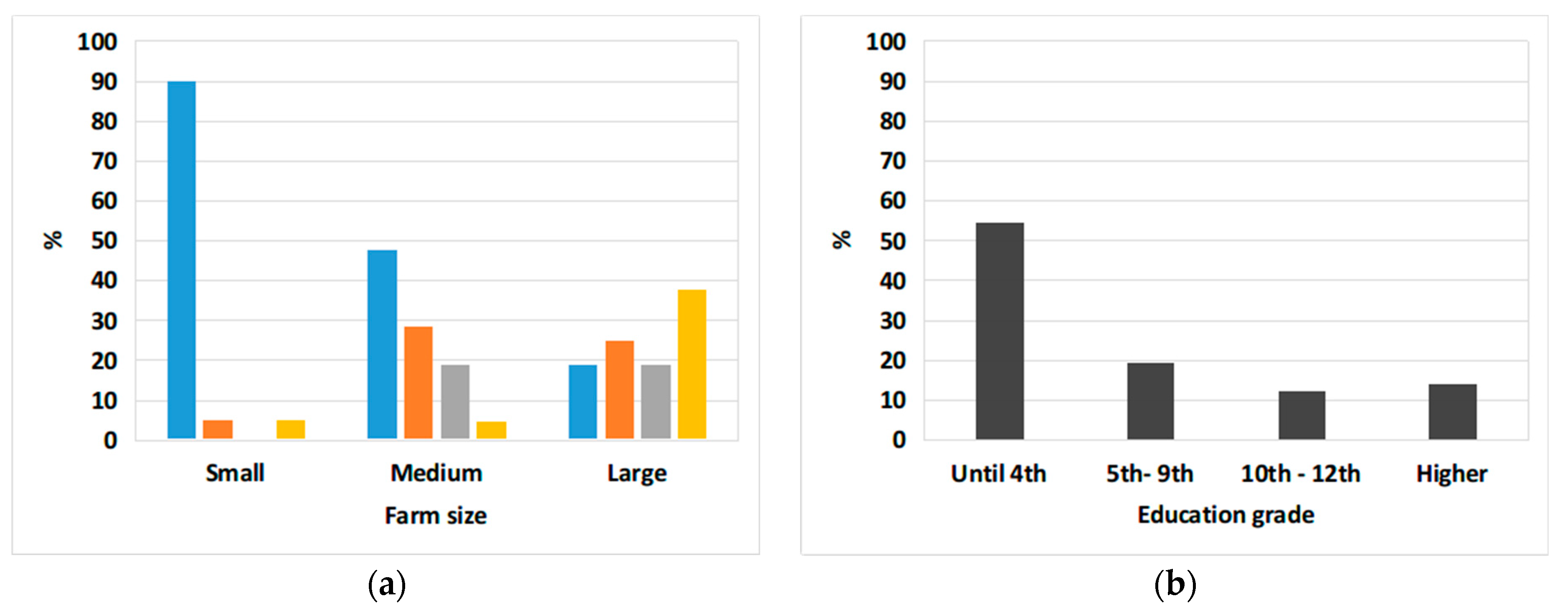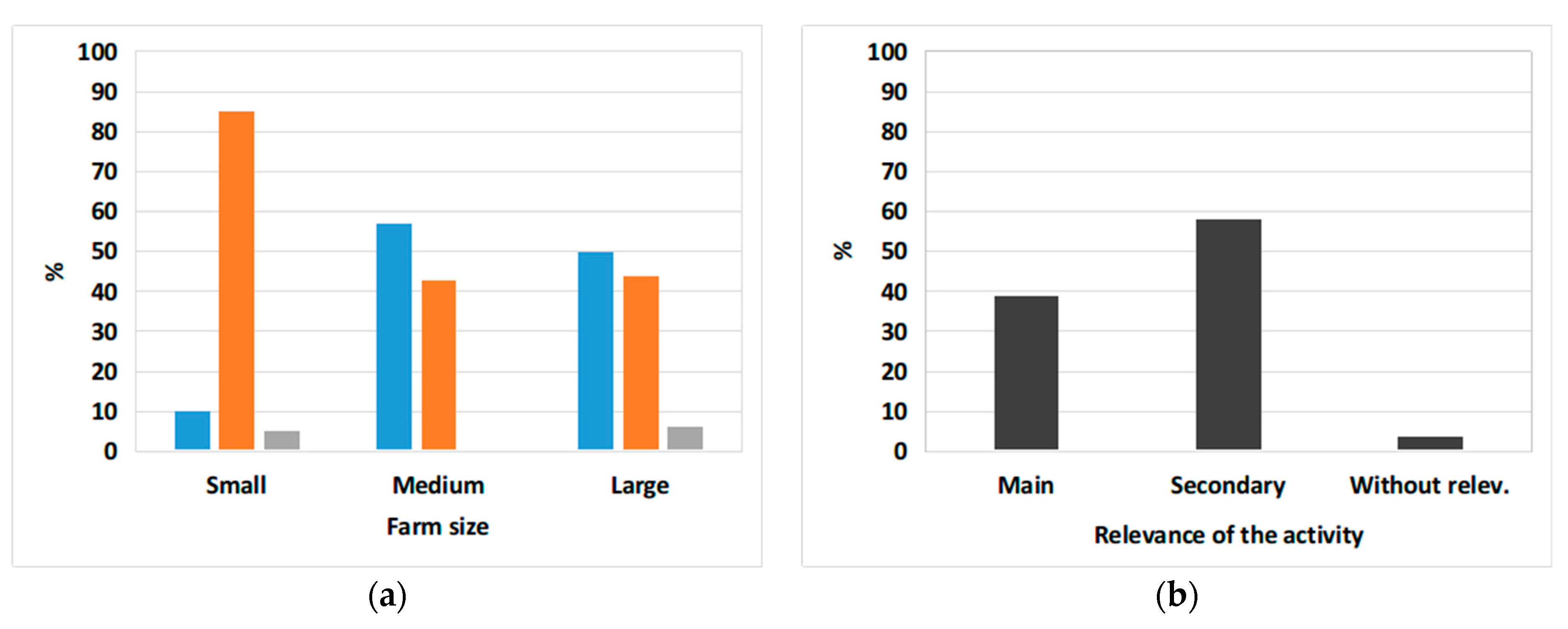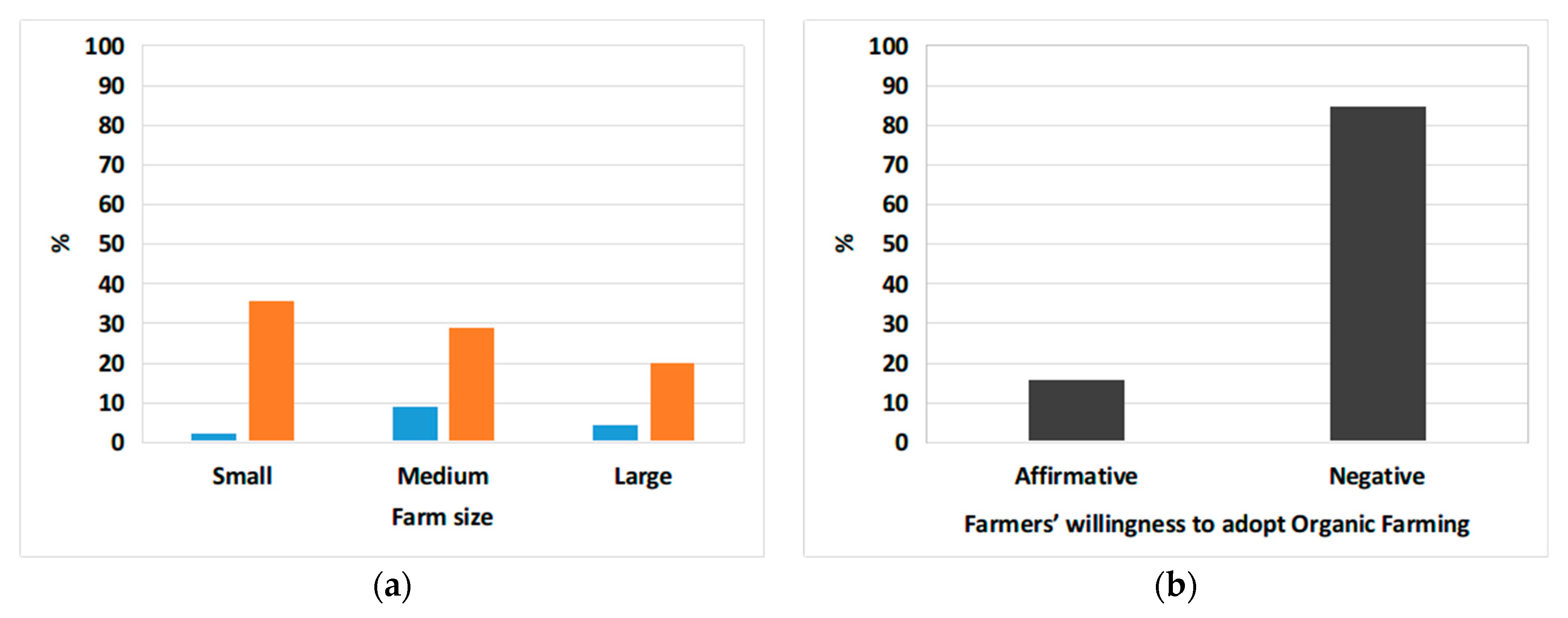1. Introduction
Organic farming (OF) is an agricultural production system that sustains the demands of production of healthy and safe food, with no significant dependence on chemical fertilizers, using organic matter and bio-fertilizers, cultivating with reduced tillage, environmentally safe pest management and the adoption of integrated farming systems [
1]. OF has the potential to contribute to rural development and food production, allowing in many situations a good compromise between farmer income, productivity, food quality and the conservation of natural resources [
2,
3], and thus, an important agribusiness for farmers, owing to the premium returns from organic products [
4]. Although the problem of food production is too complex to be solved exclusively through the production model, in some situations OF can be a part of the solution. In fact, OF not only has the potential to trigger rural development, but also to respond to the concerns and demands of modern society regarding food security and safety, and the social and environmental role of agricultural systems, which has been witnessed worldwide, for example in Iran [
5], Syria [
6], and Europe [
7]. OF can also meet the mitigation measures imposed upon agriculture by climate change emergencies, through practices such as tillage, composting, soil carbon sequestration, and energy offsets [
8,
9]. Other examples of circular economy with environmental benefits include the nutrients recycling of agricultural wastes and by-products, as well as the use of local and renewable energy sources [
10,
11].
One of the most difficult agronomic aspects of OF is crop protection, given the restrictions upon the use of most synthetic pesticides. Regarding weeds, the usual OF practices for effective control often use a combination of (i) mechanical control, (ii) crop rotation, to reduce weed potential [
12], (iii) application of bio-herbicide products [
13], and (iv) flaming [
14]. Solutions for pests and diseases control should only resort to pesticides and genetically resistant varieties authorized by official entities, for example the European Union (EU) [
15,
16]. A feature of this production mode, compared to the conventional one, is lower production efficiency, higher cost and higher labor requirements, resulting in an increased risk level, which can surpass the yield incomes of OF products.
Soil fertility maintenance is ensured through the use of certified organic fertilizers and slow acting minerals [
17,
18], which provide sustainable nutrient cycles [
19], being particularly valued those derived from composting residues or by-products from agricultural, livestock, industrial or forestry activities. Soil conservation maintaining high levels of organic matter and organic-based nitrogen relies on the use of green manure and winding, and on biological nitrogen fixation [
1]. Composting, using organic remains not only feeds the soil and the most demanding crops, but also reduces the impacts of waste disposal, improves soil quality and minimizes soil losses and allows carbon sequestration. Thus, soil management on OF systems can have considerable and positive effects on the control of greenhouse gas (GHG) emissions [
10] and plays a key role in the conservation of fertility and biological biodiversity, beyond the productivity itself [
20].
Cultivation is another aspect that requires changes from conventional practices. Conservation tillage techniques are very important in OF [
21], as well as some practical issues [
22], allowing, among other advantages, the increase of phosphorus availability and soil nitrogen content [
23]. The choice of varieties is a criterion to be considered for better fertilization efficiency, as exemplified by [
24] for rice. Crops rotation is used to better harness soil nutrient capacity and also to prevent phytosanitary problems and, consequently, decreasing pesticide needs [
1]. Mulching could be effective suppressing weeds, when retained on the soil surface [
25], and at the same time, providing organic matter to the soil. Flaming and cultivation, despite being effective tools when used together, should be considered as two of the many tools in the toolbox of integrated weed management [
14]. Precision agriculture technologies, such as robotic weeding and band steaming for weed management, could contribute to efforts to cope with pests and weed management, also reducing the labor demand [
26].
Europe has 14.6 million hectares of OF [
27], and the European policy is encouraging OF expansion [
28], in parallel with an increasing demand for organic products fulfilling effective certification standards [
29,
30], although there are several conditioning factors, like economic or crop protection [
31]. There are many examples of higher profitability in OF than in conventional farming, despite the fact that the former exhibits a reduction in physical yields, and it is offset with the higher appreciation and valorization of the market [
32,
33,
34,
35,
36,
37].
In Portugal, there are three governmental action plans: the National Strategy for Organic Farming [
38], the Action Plan for the Production and Promotion of Organic Products [
39], and the National Strategy for Green Public Procurement 2020 [
40], demonstrating the relevance given to OF, and the feasibility in various productive areas of agriculture and livestock. The OF enables stimulation of agricultural activity, as it allows the supply of highly valued new products to the market, boosting regional economic activity and rural development. OF can also take advantage of the development dynamics promoted by the development of irrigated land in Portugal [
41], especially since the most profitable crops are irrigated. In addition, in areas of minifundium, or smallholding farms, the intensification of production is crucial for reasons of farm economic profitability. Therefore, the promotion of OF in Portugal needs the mitigation of the main weaknesses of this production mode, identified by the Portuguese Government [
39]: (i) the difficulty in the supply of national organic products to accompany the growth of domestic demand, with the consequent increase in imports; (ii) insufficient production factors for OF (fertilizers, phytopharmaceuticals, seeds) available at high prices, associated with scarce information; (iii) lack of infrastructures to enable the supply concentration; (iv) insufficient organization of producers, which is reflected in weak negotiating strength and difficulties in regulating the market, in case of seasonal surpluses; (v) low representation of the OF in the usable agricultural area; (vi) weak organic livestock production and insufficient slaughtering capacity; (vii) lack of qualified professionals and offers of research and development (R&D); (viii) very high prices of organic foods for consumer; (ix) weak investment by the economic agents in concerting marketing strategies; (x) insufficient technical ministerial structure dedicated to organic production, which is reflected in the lack of statistical data on this sector.
The expectation of OF profitability in small family farming, supported by the successful examples previously mentioned worldwide, led to the development of the present study, applied to the Lis Valley Irrigation District. It addresses the issue of conversion from conventional to OF, including choosing and evaluating the most appropriate technologies, the productive paradigm change process, and the way farmers act and decide. This research objective is the assessment of constraining factors on OF expansion and outline the procedures for the acquisition of technical knowledge, the adaptation of technologies, the support for the conversion of production models, and the specialized training of farmers for this action.
4. Discussion
The results obtained in this study relative to the LVID concerning the land, demographic and socioeconomic characteristics highlight a number of difficulties in relation to agricultural modernization and the adoption of OF. The constraints to OF development, mainly related to the land and social profiles, include: (i) the land structure of the farms, such as the small sized parcels and their geographical dispersion, or the small-sized farms; (ii) the land use, by the landowner or by the lessee, that affects their prospect to make long term investments; and (iii) the age and training of farmers, which impacts their predisposition to adopt more advanced and complex technologies, or to take greater risks. Land ownership is a fundamental issue, because it hinders long-term OF investments, and also the predisposition for the conversion to OF, given the return uncertainty. In fact, the legal requirement of a minimum of three years conversion time for certification of OF vegetables [
55], makes the profitability of this transition period crucial.
The major number of fields (78%) of the LVID are cultivated by the owners, which in itself is a good indicator. The fact that the landowners cultivate the land is an important aspect. However, the smallholding situation with very small fields (see
Table 1), being 94.6% of the fields lower than 0.5 ha, results in very strong constraints on development. There are several reports (e.g., Murray and McGrath [
56], Ruhf and Wagner [
57]) of studies carried out on the issues of investment, land cost, land ownership, and return on investment related to land valuation. Regarding land ownership and the barriers to sustainable agriculture, Carolan et al. [
58] concluded that the tenant uncertainty is a barrier to sustainable agriculture and that joint work between landowners and tenants is required to reduce that uncertainty and ensure continued investment. Ciaian et al. [
59] point out that, although the sale value of agricultural land is higher than the lease value, sales are encouraged due to the security investment they convey, because transferring all property rights to the new owner allows easier access to credit, as land can be given as collateral. In most European Union (EU) countries, the rental market appears to be more important than the sales market and a large part of the agricultural area is leased. According to Ciaian and co-authors [
59], Portugal in 2007 had one of the lowest leased land rates in EU, under 25% of the used agricultural area (UAA). The positive influence of age and education on entrepreneurship in OF is a central issue, where generational renewal plays a particularly important role for innovation and development [
60]. Younger farmers with higher academic and agricultural background have more resources to manage new technologies and deal with the most demanding market competition contexts, creating new development models around the OF concept, based on shared projects with related topics, such as the green and circular economy [
61,
62].
The LVID farmers marked a clearly negative predisposition to the adoption of OF where the main factor was the problem of insufficient public support (
Table 5, 58% of responses), relevant in the conversion period required by the certification process. Therefore, all public actions that facilitate the conversion phase will have a significant effect on promoting OF, through farmers’ decisions with their consequent multiple benefits on rural development and food security.
Certification is the procedure to guarantee compliance with obligations under the law safeguarding the achievement of the OF objectives [
63], and it has gained increasing attention worldwide, being essential to provide a safe assurance to the market of the compliance with OF principles and standards [
64]. The somewhat complex process of obtaining certification includes many challenges ahead and the process in itself affects the decision to convert a conventional farm [
65]. There are several examples that demonstrate these difficulties, like in Spain [
37], or in Germany [
66]. Before starting the OF activity, the farmer must prepare a preliminary assessment to identify the contamination risky areas, the historical context of fertilization and pesticides, and to perform chemical analyzes to the soil and water. The transition period until the OF certification will depend on the actual soil and water conditions, and the type of crops grown. In general, this period takes, at least, three years. This lag time has significant costs to be supported by the farmer, due to loss of yield and uncertainty about conversion efficiency. This microeconomic framework explains the need for public support for this process, justified to compensate for this inevitable loss of farm income.
Results of these studies also showed that marketing is a main decision factor (vd.
Figure 5, assurance of market outlets, plus market prices, correspond to 35.6%), and highlighted the importance of short marketing circuits to solve this issue. On the other hand, the role of small family farming also promotes the OF feasibility because it facilitates access to local markets for greater flexibility and smaller size. The organization of production is a very important aspect for the OF viability and competitiveness [
67]. The characteristics of family farming give them special aptitude for OF, namely for vegetables production, due to their labor flexibility and availability [
68,
69]. The Portuguese government considered small family farming very important to the OF development, due to their weight in terms of national number of farms (242.5 thousand farms, 94% of total), using 54% of utilized agricultural area (UAA) and 80% of total agricultural labor [
70]. The Family Farming Statute emphasized the need to support the creation of proximity markets and short circuits and the creation of a specific public procurement regime for proximity agrifood products [
52]. Family farms can exploit the opportunity of short circuits that demonstrate social, economic, and environmental advantages [
71,
72], especially in the EU, although the results depend to a great extent on each situation [
73]. Gonçalves [
74] reported the high potential for OF of small family farming with a positive impact on the development of the traditional irrigation systems in the Center and North of Portugal, by linking agriculture with landscape, environment, and nature conservation, and by valuing specific agricultural products, such as aromatic and medicinal plants, through the economic activity of rural tourism and regional cuisine.
A comparative analysis of the OF practice in Portugal and in other European countries, namely Spain, Italy and Greece, also in a Mediterranean climate, and in the Czech Republic, with a different temperate-continental climate, based on published statistical data, is presented in
Table 6. In the EU, 11.9 million ha are occupied with OF, 61% of which with the dominant crop, pastures and forages for biological livestock. The importance of these crops varies significantly from the Czech Republic (84.2%) to Italy (27.6%). In Portugal, the permanent pastures and forage crops occupy 58.3% of the OF production area, mainly located in the Southern continental region and in Azores Island. Conversely, the representativeness of vegetable crops per country is much smaller, almost without expression in the Czech Republic (0.1%) to an area over 60,000 hectares in Italy (2.6%). Greece, Portugal and Spain (0.5% to 0.7%) all together grow these types of crop in 27,251 ha. It is worth noting that in Greece, olive and vineyard crops, although with little expression in the cultivated area, show significant profitability [
75].
In these countries, the average area per farm surpasses 50 ha, except in Greece. In fact, there is a tremendous variability in the farms size, from 7.5 ha in Greece to 180 ha in Czech Republic. The Portuguese average size (110 ha) also results from a great variance in the farms size between regions, as in the South of the country there are extensive production systems, while in the Center and North minifundium prevails. Comparing these national data with the LVID, it can be seen that: (i) the size of the plots is much smaller than in the South of Portugal, with the production of rainfed permanent pastures not being viable; (ii) the difficulties in opting for animal production in OF have the impact of not having converted pasture and forage areas, the most representative with an occupation is about 60% of the irrigated area. In line with this, a new perspective on the OF production system of the countries emerges, if this information is crossed with the percentage of farms with less than 2 ha (Greece, 50.6%; Portugal, 46.1%), contrasting with Spain and Italy and the Czech Republic (10.3%). The average size of the farms in the LVID is about 0.64 ha, characteristic of a minifundium area, which is possibly a relevant aspect restricting the OF development in the LVID.
Concerning the farmers’ age, the OF holders are older than non-organic farmers. The age of farms managers with and without organic area are strikingly different: farmers younger than 55 represent 61% of the organic sector, whereas they represent only 45% of the conventional sector, overall in the EU [
76]. The OF farmers under 35 years old only represent 0.2% of farmers in Portugal, a lower ratio than the Spanish or the Italian ones (1.3% and 2.1%, respectively) (
Table 6).
Regarding the markets, Spain and Italy have a higher annual demand of OF products (42 and 52 euros per capita), and Portugal, the lowest values of this set of countries (2 euros per capita), with a organic share of 0.2%. These data highlight the relationship between the market demand and the reduced stimulus to the expansion of OF in Portugal.
The OF development in the LVID should include actions to support the farmers, like those to promote organic products such as the representation of producers in national and international exhibitions, the development of a communication plan to locate organic production or marketing units of mobile applications, and involving regional public purchases [
38,
39]. These strategies can help organic product marketing and their appreciation by the consumer, being the lever element for the development of this production mode. In addition, further actions to support farmers are foreseen, especially for certification, technical support and marketing, involving farmers and water user’s associations, research entities and the ministry of agriculture. Lis Valley agriculture is fully dependent on the irrigation infrastructures, and aiming at its development, the National Irrigation Plan [
79] foresees its modernization. To support water management and farm competitiveness through innovative practices, namely those of OF, an operational group project is in action [
80,
81].
5. Conclusions
Organic farming can play an important role in rural development by reinforcing the penchant for sustainable agriculture and its role for ecosystem conservation. The effectiveness of OF could be particularly relevant in areas of family farming, taking advantage of the increased availability of labor and the value of short marketing circuits.
It was concluded that the farmer’s land structure, low education level and high age, constrains organic farming development. Also, farmers face a number of uncertainties that explain the low adherence to this production mode, namely the certification process, the technical knowledge of new technologies, especially crop protection, and the problems of marketing and guaranteeing profitability.
It is also concluded that the role of the state is clear in prioritizing rural development policies and the promotion of OF through support for land restructuring, modernization of irrigation, stimulation of young farmers, conversion and implementation of innovative technologies, and the organization of farmers for better productive efficiency and market access.
Finally, the study concludes that organic farming has significant potential for stimulating rural development in the Lis Valley and that the efforts and resources of the various stakeholders need to be harmonized to deliver effective support to farmers.
